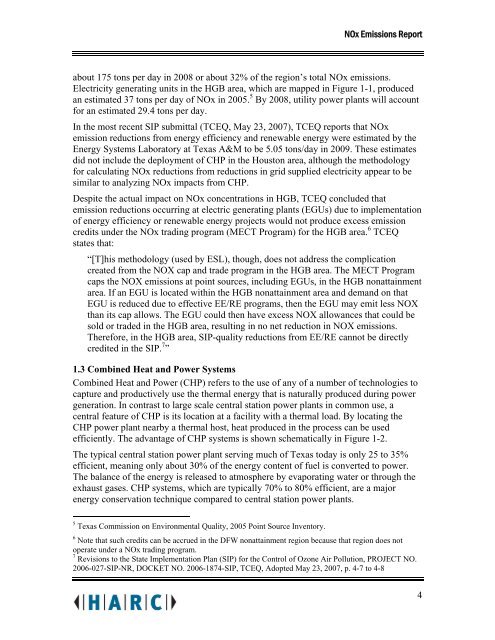NOx Emissions Impacts from Widespread Deployment of CHP in ...
NOx Emissions Impacts from Widespread Deployment of CHP in ...
NOx Emissions Impacts from Widespread Deployment of CHP in ...
Create successful ePaper yourself
Turn your PDF publications into a flip-book with our unique Google optimized e-Paper software.
<strong>NOx</strong> <strong>Emissions</strong> Report<br />
about 175 tons per day <strong>in</strong> 2008 or about 32% <strong>of</strong> the region’s total <strong>NOx</strong> emissions.<br />
Electricity generat<strong>in</strong>g units <strong>in</strong> the HGB area, which are mapped <strong>in</strong> Figure 1-1, produced<br />
an estimated 37 tons per day <strong>of</strong> <strong>NOx</strong> <strong>in</strong> 2005. 5 By 2008, utility power plants will account<br />
for an estimated 29.4 tons per day.<br />
In the most recent SIP submittal (TCEQ, May 23, 2007), TCEQ reports that <strong>NOx</strong><br />
emission reductions <strong>from</strong> energy efficiency and renewable energy were estimated by the<br />
Energy Systems Laboratory at Texas A&M to be 5.05 tons/day <strong>in</strong> 2009. These estimates<br />
did not <strong>in</strong>clude the deployment <strong>of</strong> <strong>CHP</strong> <strong>in</strong> the Houston area, although the methodology<br />
for calculat<strong>in</strong>g <strong>NOx</strong> reductions <strong>from</strong> reductions <strong>in</strong> grid supplied electricity appear to be<br />
similar to analyz<strong>in</strong>g <strong>NOx</strong> impacts <strong>from</strong> <strong>CHP</strong>.<br />
Despite the actual impact on <strong>NOx</strong> concentrations <strong>in</strong> HGB, TCEQ concluded that<br />
emission reductions occurr<strong>in</strong>g at electric generat<strong>in</strong>g plants (EGUs) due to implementation<br />
<strong>of</strong> energy efficiency or renewable energy projects would not produce excess emission<br />
credits under the <strong>NOx</strong> trad<strong>in</strong>g program (MECT Program) for the HGB area. 6 TCEQ<br />
states that:<br />
“[T]his methodology (used by ESL), though, does not address the complication<br />
created <strong>from</strong> the NOX cap and trade program <strong>in</strong> the HGB area. The MECT Program<br />
caps the NOX emissions at po<strong>in</strong>t sources, <strong>in</strong>clud<strong>in</strong>g EGUs, <strong>in</strong> the HGB nonatta<strong>in</strong>ment<br />
area. If an EGU is located with<strong>in</strong> the HGB nonatta<strong>in</strong>ment area and demand on that<br />
EGU is reduced due to effective EE/RE programs, then the EGU may emit less NOX<br />
than its cap allows. The EGU could then have excess NOX allowances that could be<br />
sold or traded <strong>in</strong> the HGB area, result<strong>in</strong>g <strong>in</strong> no net reduction <strong>in</strong> NOX emissions.<br />
Therefore, <strong>in</strong> the HGB area, SIP-quality reductions <strong>from</strong> EE/RE cannot be directly<br />
credited <strong>in</strong> the SIP. 7 ”<br />
1.3 Comb<strong>in</strong>ed Heat and Power Systems<br />
Comb<strong>in</strong>ed Heat and Power (<strong>CHP</strong>) refers to the use <strong>of</strong> any <strong>of</strong> a number <strong>of</strong> technologies to<br />
capture and productively use the thermal energy that is naturally produced dur<strong>in</strong>g power<br />
generation. In contrast to large scale central station power plants <strong>in</strong> common use, a<br />
central feature <strong>of</strong> <strong>CHP</strong> is its location at a facility with a thermal load. By locat<strong>in</strong>g the<br />
<strong>CHP</strong> power plant nearby a thermal host, heat produced <strong>in</strong> the process can be used<br />
efficiently. The advantage <strong>of</strong> <strong>CHP</strong> systems is shown schematically <strong>in</strong> Figure 1-2.<br />
The typical central station power plant serv<strong>in</strong>g much <strong>of</strong> Texas today is only 25 to 35%<br />
efficient, mean<strong>in</strong>g only about 30% <strong>of</strong> the energy content <strong>of</strong> fuel is converted to power.<br />
The balance <strong>of</strong> the energy is released to atmosphere by evaporat<strong>in</strong>g water or through the<br />
exhaust gases. <strong>CHP</strong> systems, which are typically 70% to 80% efficient, are a major<br />
energy conservation technique compared to central station power plants.<br />
5<br />
Texas Commission on Environmental Quality, 2005 Po<strong>in</strong>t Source Inventory.<br />
6<br />
Note that such credits can be accrued <strong>in</strong> the DFW nonatta<strong>in</strong>ment region because that region does not<br />
operate under a <strong>NOx</strong> trad<strong>in</strong>g program.<br />
7<br />
Revisions to the State Implementation Plan (SIP) for the Control <strong>of</strong> Ozone Air Pollution, PROJECT NO.<br />
2006-027-SIP-NR, DOCKET NO. 2006-1874-SIP, TCEQ, Adopted May 23, 2007, p. 4-7 to 4-8<br />
4
















